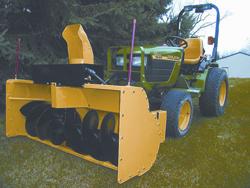
"Last winter I built a front-mount snowblower for my Deere 4100 compact utility tractor. The blower is 59 in. wide, 28 in. tall and weighs about 350 lbs.," says Jim Gerken, Zumbro Falls, Minn.
"I wanted a single stage blower to keep impeller wear low since I would be using it on my gravel driveway. I designed it to fit Deere's front quick-tach system which lifts the blower and powers it with a 2,100 rpm pto.
"I used a 1:1 ration right angle helical gearbox to run the power over to the side of the blower where I installed a 2:1 reduction chain drive on the side. The chain drive is completely enclosed and has a sliding tensioner made from UHMW plastic. There's a shear pin in the pto driveline running over to the chain drive.
"I made the impeller itself from a 1.25 dia. shaft fitted with a 4-in. dia. center pipe. I attached 15-in. dia. auger flighting to the center pipe, using both right and lefthand helicoils. As I welded the flighting into place, it was carefully adjusted for proper balance after each step of the process. To do this, the shaft was allowed to roll freely on a pair of knife edges and weight was added as I went along to balance it out. Even the seam weld on the 4-in. center pipe was counterbalanced with small sections of steel stock welded on.
"Two righthand helicoil flights -- interwoven together -- feed from one side and two left hand helicoils feed from the other side. Each section of flighting attaches to a paddle at the center -- four paddles total -- which each have a small cupped side opposite the flight serving it. The paddles are sloped backwards from the rotation direction 10 degrees on the main tube so snow will not stick.
"Impeller speed is 1,050 rpm's at pto speed. With the 15-in. dia., that's about 4,000 ft. per minute velocity out the chute.
"Clearances between the impeller and the housing were kept as tight as possible at less than 1/10th in. The chute rotator was built using a small hydraulic cylinder and cable sheaves to give a 3 to 1 distance advantage. In other words, the cylinder's stroke length is amplified by three to get a nice 300 degree rotation, using the cable and sheaves in a manner opposte what you would normally think of in a force-amplifying block and tackle arrangement.
"Last last winter we had a couple heavy snows which I used for testing before painting and the performance was very good. Imbalance was at a level that was undetectable."
